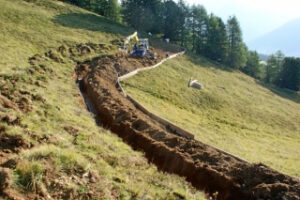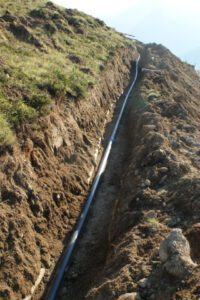Water Supply
Water Supply





Regular renewal work
The water pipeline network also needs to be maintained and renewed. In particular, the partially used pipes made of clay must be gradually replaced. Below you can see pictures of the renewal in the Podestatenalp area. Partly you can see on the pictures next to the new pipe the old pipe made of clay elements, which had to be replaced.
It is known from traditional sources that the Schatzberg had a permanent settlement already in the Middle Ages. Later, at a time unknown to us, the settlement on the Schatzberg became a Maiensäss, which was inhabited only in the spring and summer months. These inhabitants must have caught the nearby springs quite early and led them to the stables and houses. The earliest known spring testifies that the Accola farm had a proper water supply with a brick well casing and iron water pipes. The lowest spring, belonging to the water supply of the Schatzalp, still shows an ancient masonry well and old iron pipes. It must have been part of the old rural water supply.
All our water sources are different and each has its own character. Some bring more water in spring and less in autumn, others are very consistent. Some are cold, others warmer. Some of them carry a lot of sand and mica particles and therefore have to be first passed through an elaborate sand trap and filtered. Our drinking water is of the highest quality, which is ensured by continuous controls.
In most cases, the water outcrops are located far below the ground surface and can only be reached via shafts, stairs and tunnels. Therefore, in addition to good clothing and a flashlight, a helmet as head protection is a must for an expedition into the realm of the springs.
If the water now reaches the Schatzalp through kilometer-long pipes, it is first collected in a two-chamber reservoir about 60 meters above the hotel. This is the last opportunity to deposit the fine sand that has been washed down with the water. The first chamber, with a capacity of 140 cubic meters, contains the so-called fire water reserve. The use of this water is reserved for the fire department. Only when this basin is full does the water overflow into the so-called drinking water reservoir and is available to the many users in the kitchen, laundry room and of course in the guest rooms. You have probably already noticed the large clock in the forest. It gives us information about the water level in the drinking water reservoir.
Our drinking water is regularly checked by the responsible authorities for hygienic safety and meets the high requirements for drinking and table water without any problems.
Original text by Oscar Miller, edited and updated by Pius App
